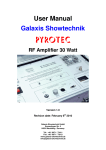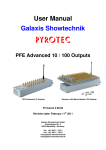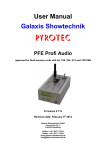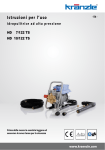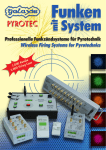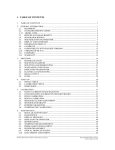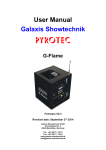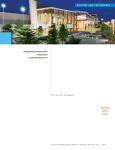Download Operation manual (english menu)
Transcript
Operation Manual Galaxis Showtechnik PYROTEC PFE Mini 5 Outputs Software V2.81e -2- Table of contents Page Safety regulations Development and manufacturing General Notes Description of the control elements Switching on and normal mode The menu Wireless firing mode Microphone firing mode The process of firing by microphone Function of level and rate when operating with microphone firing Examples of different sound events Safety notes when operating with microphone firing The stepping function (optional) Differences between various battery types Firing power Operation of the charging unit Warranty Disclaimer Approval Technical Data -3- 4 8 8 9 9 11 11 12 14 16 17 17 18 19 20 21 22 22 22 23 Safety regulations Date: Sept. 19th 2007 Safety regulations for the firing aerial shells by using e-matches: of pyrotechnical effects and The following instructions are for your understanding about important and basic safety principles. Our general safety requirements are based on our own experience plus the contact and feedback from our customers. These rules allow the safe and successful usage of all components of our wireless firing systems. With proceeding development of our products, we will continuously revise and adapt the safety standards in conclusion with your notifications and support. The following safety regulations are part of all our operation manuals within our product range. These regulations are also available in printed form and can be downloaded via our internet homepage at any time. Please forward these instructions to any relevant persons in your company dealing with this topic. Any technical device can potentially cause a fault. This could be encouraged through: wrong usage, unit damage, unit aging as well as the wear and tear of the unit. This fundamental thesis was the basic principle when writing these instructions. 1. Smoking or open fire is strictly prohibited within the safety zone! 2. Depending on the type, size and quantity of the pyrotechnical effects that are being used and depending on the local conditions, allocate the necessary fire prevention and first aid measurements. 3. In all cases respect and follow any national and technical regulations as well as the operation manuals respective to the pyrotechnical effects in use. 4. Make sure that non authorized persons are not within the vicinity of the pyrotechnical effects and to the respective firing system. 5. The safety boundary distances required by the manufacturer and authorities are to be respected. Secure the area so that non authorized persons cannot gain access to the same. 6. The operation manuals and safety instructions of the pyrotechnical manufacturers must be observed at all times. If in doubt these must be discussed with the relevant safety organisations. 7. The usage of pyrotechnical effects as well as the respective firing systems are only allowed to be used according to it's defined function. -4- 8. The components of our firing system are to be covered or encased against burn-off cinders or weather conditions where necessary. Electrical contacts should be protected against corrosion, soiling and damage plus they should be cleaned regularly. 9. The contacts of the pyrotechnical articles or their e-matches, which have not yet been connected, must always be short circuited. 10. We recommend to have our products inspected every one to two years. Along with the testing of the rechargeable battery, a visual test as well as a functional test will prove that the operational safety standards are still met. 11. Do not use damaged equipment. If a damage is found, immediately send the device back to the manufacturer for professional repair. Our warranty for the proper function for our equipment is only for components of our system, which have no damage. 12. Any changes in the devices or to the firing system as well as repair work on the units other than that through the manufacturer will invalidate any warranty claims and our product liability will be void. Should repair of the units be necessary, then we do require a detailed report of the problem. 13. Please make sure when lending or renting out the equipment, that no damage has occurred during the rental period of the units. Advise your staff, that it is very important to report any possible damage of the units immediately. Customers, which have borrowed or rented the equipment are hereby informed, that it is their duty to report any damage found or suspected on the unit when returning such. 14. Wire connections from the firing device to the e-matches are always to be insulated. At the same time avoid wire damage, for example through heat, cable twisting, cable pinching and burn-off cinders or through forced piercing. All cables must be checked before each use on it's faultless construction. When using used wires we do recommend a continuity and short circuit test between each insulated connection before using it again. 15. The firing of igniters in accordance with 'SprengG' (i.e. German explosives law) is not allowed with our products. For this purpose only firing units with a BAM certification in accordance with §5 'SprengG' or equivalent are allowed. The same applies to high explosives. 16. Avoid unintended firing through electrostatic charging. When using e-matches, make sure that you only use those types, which are protected against unintended firing through electrostatic discharges. The e-matches you use should also have a BAM certification or equivalent. 17. Avoid possible or even physical contact of the e-matches or their firing lines with other conductible materials if the possibility is given that either a static discharge or potential equalization can arise. -5- 18. Make sure that no unintended firing possibilities are given. Commonly caused either through strong electrical, magnetic, electromagnetical fields as well as other voltage sources. 19. An often underestimated risk are unintended firings due to live contacts found as charging contacts on mobile phones, walkie talkies as well as rechargeable battery driven tools. Even when due care and attention is taken, a battery pack or similar can be a hazard when dropped especially when live contacts are revealed. 20. Unintended firing can be caused by thunderstorms or the electrostatic fields during the drawing up of a thunderstorm. We recommend clearing and securing the area in question. 21. Another possible danger for unintended firings are potential equalization currents. Be aware that these currents may occur in between conductive building segments themselves or between these conductive segments and earth potential. Neither e-matches nor wiring should come in contact with such segments. 22. Please be aware that through your pyrotechnical effects ionized gases are created. The thereby produced ions increase the conductivity within the air. This ionization process can cause an electrical arcing especially within the vicinity of high voltage overland cables. This may lead to lethal consequences for the pyrotechnicians and other persons. Please note that wind conditions can be totally different a few meters above the ground. 23. Please assure that the firing can only be initiated through the pyrotechnician. Keep firing system under lock and key! Within our safety concept, all firing systems are set with individual codes, which inhibit unintended and accidental firing through third parties. If requested we can also supply systems with the same coding. This may be necessary if in a company more than one transmitter is used or when companies exchange the units between each other. 24. With our using the key code numbers 901 and 311, we are using a standard key code, which can also be found in other products. On a customer's request we can also supply other key codes. 25. Please ensure that the relevant safety distances are met by everybody. The safety margins are to be kept as from the beginning of the project until the pyrotechnician releases the area after firing and containment of unfired effects and shells. 26. Connect at all times first the e-match to a 100% non-live firing line, which is also not connected to a firing unit. A pyrotechnical effect is given from the time onwards as 'armed' when the e-match wires are connected to the firing unit. This is independent if the units are on or off! 27. In the interest of your own safety and protection of the devices always use a sufficient length of firing wire. -6- 28. Along with a sufficient length of firing wire you should ensure also the following: In the field of display fireworks: The fireworks shells are only allowed to be loaded after the mortars have been stabilized and secured. Only after loading it is then allowed that the e-matches are connected to the respective firing units. At all times the most important rule is to never put your head or other part of the body into or over the mortar opening. This would also apply to other pyrotechnical effects. In the field of special effects: Depending on the explosiveness of the pyrotechnical effects or materials that are being used it is advisable to proceed with higher care and attention (lies within the pyrotechnician's responsibility) and this could include for example a short circuit bridge over the contacts of the e-match to prevent unintended firing. Also it is possible to make a physical switch breakage in the firing line, which is only then closed when all safety regulations are met and kept! Should there be any unclarified situations, then discussions with the safety authorities are to be taken until all is clear for everyone. When it comes to the safety of your projects we are at all times at your disposal to develop a customized safety concept. 29. Make sure the devices are switched off before connecting the ematches. 30. When checking the various system parameters as well as during firing, nobody is allowed within the danger zone. 31. After the effects have been fired, an ample amount of time should be given before disassembling the pyrotechnical setup. Before securing possible unfired effects first disconnect the corresponding wiring and then switch off the receivers. Especially in the field of special effects, during the installation special care should be taken of how to disassemble unfired effects or installations in a safe way. The most current version of the safety regulations is always available in the download section of our website: www.galaxis-showtechnik.de -7- Development and manufacturing Galaxis Showtechnik GmbH A. Buchner, R. Kränzle Emmertinger Straße 2 Germany - 84524 Neuötting Phone +49 / 86 71 / 7 34 11 Fax +49 / 86 71 / 7 35 13 www.galaxis-showtechnik.de email: [email protected] General Notes This section describes the special features of the miniature receiver PFE Profi 5 and is intended as an addition to the other manuals of the system. This device is a receiver that has been designed especially for the use in the areas theatre and special effects. Its purpose is not to replace the other receivers, but to open up new applications. Technically viewed it contains a completely different power concept. The used AA-cells may be deterrent for some people because they cannot imagine that they provide enough power for a reliable ignition. Without any technological support this is certainly true. Therefore the miniature receiver contains two circuits that increase the battery voltage. For the operation of the processor and receiver module 5 Volt are produced and for the charging of the ignition capacitors 30 Volt are produced. Please note that there is a charging capacitor for each output to prevent the short circuit of an output from affecting the ignition power of the next output. The stored energy in the AA-cells is utilised completely. The device operates down to a voltage of 0.4 Volt per cell. The full ignition power is at your disposal in the complete range of cell discharge. The integrated opportunity of ignition with acoustic signals (ignition by microphone) is a valuable feature for the realistic simulation of body hits. Due to arming this function by a radio signal, maximum safety is provided. Of course you can adjust the microphone sensitivity in a wide range. Note: To design the device as user-friendly as possible only ignition channels from 1 to 99 can be programmed. The channels from 100 to 999 will be ignored during programming and firing. -8- Description of the control elements 3 1 2 4 1 LC-display Displays all information and is readable in all light situations due to illumination during menu or after each activation of 'Mode'. 2 Hole with internal microphone behind it or socket for external microphone Please direct the orifice to the acoustic source. A free line of sight is advantageous. If your device has been equipped with an external microphone plug it in here. 3 Output terminal Clamp wires of the electric matches with the supplied clamping tool here. The front panel shows channel assignment of the terminal. 4 Sensor field 'Mode' This is the sensitive area for the magnetic pen. On the back of the device you will find Battery container To change batteries open cap by unlocking the catch. Insert new batteries and pay attention to correct polarity. Put on the cap again and lock it with the catch. Belt clip (optional) Use this clip to fasten the device in a convenient way. Optionally the device may be equipped with an external wire antenna. Switching on and normal mode Prior to operation ensure that good batteries are inserted. Never use two different battery types or differently discharged cells. -9- Galaxis PYROTEC V2.81e To switch the device on activate 'Mode' with the magnetic pen. You see this start message in the display, including the software version. Then you see this display of the normal mode. The remaining battery capacity is diplayed for example as 'AC:85%'. AC = 'Akkumulator/Battery Capacity'. Please note that this result relates to a temperature of 20 degrees centigrade and depends on ambient temperature. When operated at temperatures below 0 degrees centigrade it is possible that a fully charged battery is displayed with 70% because its voltage is lower than at room temperature. 12345|AC:85% |IS: 0% - |RT: ?% A line below the signal strength of an interfering carrier on the used radio frequency is displayed. 'IS' = 'Interfering signal strength'. In this example there has been no signal detected and 0% is displayed. Values below 30% are unproblematic. In the display's bottom line the result of a range test will be shown. 'RT' = 'Range test'. In this example, no range test has been executed and therefore no result can be displayed. In the top line you read '12345'. This marks the columns of the outputs 1 to 5 to enable displaying of control symbols. On the left side of the bottom line a bar is moving forth and back. This demonstrates that the device is in reception mode. After switching on the ignition capacitors will be charged. After about 30 seconds this charging progress is finished. The capacitors will be recharged in predefined intervals. So if you wait the first 30 seconds you will never have to worry about insufficient charging. After editing the menu and after an ignition a new charging process will be initiated. 12345|AC:85% *** |IS: 0% - |RT: ?% If you clamp on a e-match and the electric contact is faultless then you will see a star symbol below the corresponding output number. In this example the outputs 1, 2, 3 have been connected with an electric match properly. 12345|AC:85% *** |R.TEST - |RT:70% After initiation of a range test the result will be displayed like that. 'R.TEST' = 'Range test'. In the bottom line the result - in this case 70% - will be displayed. 12345|AC:85% *** |IS: 0% - |RT:70% After the test the result remains in the display until a new test will be initiated or you enter the menu. Before each range test the result should be deleted (by entering the menu) to prevent that the old result is pretending sufficient range. 12345|AC:85% *** |F.MODE - |RT:70% 12345|AC:85% *** |CH: 17 - |RT:70% If you enter the transmitter's ignition mode 'F.MODE' will be displayed. 'F.MODE' stands for 'Firing Mode'. If you fire an ignition channel it will be displayed like that. If an output has been programmed with this channel it will be ignited. A box as a symbol for ignition will appear in the column of this output. In this example output 1 will fire the e-matches. Note: If you want to read the display in darkness a short activation of 'Mode' will illuminate it for a certain period of time. - 10 - The menu Note: All settings of the menu are stored and will be present the next time of operation. Each change of settings will be stored when leaving the menu. If you enter the menu the display will be illuminated continuously until you leave it. If you activate 'Mode' for a longer time you will enter the menu. ----Menu---Switch off or continue First you have the opportunity to switch the device off or to continue with editing the menu. If you activate 'Mode' for a short time you will continue. If you activate 'Mode' for a longer time you will switch off the device. You have activated 'Mode' for a short time and now you have reached this menu item. Here you can determine the used type of battery. This is necessary because calculation of the AC-result depends much on the used battery type and its discharge curve. If you activate 'Mode' for a short time you will proceed without change. If you activate 'Mode' for a longer time you will change the battery type between the following: Alkaline, NiCd, NiMH. The maximum battery lifetime will be displayed in brackets. ----Menu---Batt./Accu: Alkal.(27h) ----Menu---Loudspeaker: On ----Menu---Operat.Mode: Wireless F. ----Menu---Operat.Mode: MIC Firing The next item enables the user to turn the internal loudspeaker respectively its acoustic signals on or off. This comes in handy when these signals are disturbing. In this case you have to navigate through the menu without the support of these signals. A long activation of 'Mode' changes the setting and with a short one you skip this menu item and proceed to the next one. Now you have to determine the operation mode. You can opt between these two: 'Wireless Firing' or 'MIC Firing'. A long activation of 'Mode' changes the setting and a short one skips this menu item and you will enter the next one. In this example the microphone firing mode has been selected. The following section describes the configuration of the wireless firing mode. The parameters of microphone firing will be explained later. ----Menu---Memory: Keep up First you have the opportunity to delete the programmed firing channels or to edit the already programmed channels. 'Keep up' means that the stored information is preserved and can be edited later. If you activate 'Mode' for a longer time the following appears: ----Menu---Memory: Delete Here all programming information will be deleted. With a short activation of 'Mode' you will enter the next menu item. Please note that if you have selected to delete the channel memory only the programming of the channels for the wireless firing mode will be erased because this is the menu for firing by radio. The settings of the microphone firing mode will remain unchanged. - 11 - Now you can assign a firing channel to output 1 if desired. In the example no channel has been programmed yet because you see '--' instead of a channel number. To change the channel starting with 1 simply activate 'Mode' for a longer time and put the magnetic pen away if the desired channel has been reached. The programming with the magnetic pen is a little complicated so you may also program the channel by radio. Simply turn on your transmitter, select the desired channel in normal mode and start a range test (With PFC Advanced go to manual firing mode, enter the desired value as a channel and then press the programming button). The receiver decodes the channel information and after a moment the programming appears in the display. You may program the output again and again. If you set the transmitter to channel 0 and start a range test (press the programming button on the PFC Advanced) the programming of the edited output will be erased and '--' will be displayed. If you do not have your transmitter at hand, you will always have the opportunity to program the channel with the magnetic pen. ----Menu---Programm. of Output 1: -- ----Menu---Programm. of Output 1: 37 Channel 37 has been assigned to output 1 here. If you are content with this setting activate 'Mode' for a short time and you will reach the programming of output 2. If you have programmed all outputs you will find yourself back in normal mode and may begin with sending firing commands. If you have had selected the microphone firing mode the menu will be adapted in the following way: ----Menu---Memory: Keep up You know this menu item already. But now if you select 'delete' the only parameter which will be deleted is the channel which arms the microphone firing mode and the parameter 'MIC Offset'. The other programming will not change and will have no effect on the microphone firing. The other parameters of microphone ignition (level and rate) will not be deleted, too. Enable MIC Firing With Channel: -- Now you have to determine the channel that will arm the ignition by microphone later. Please note that you may also program a channel that is used as a firing channel with another receiver. In this case firing an e-match and arming of firing by microphone would be simultaneous. Enable MIC Firing With Channel: 1 Channel 1 has been programmed here. This is useful if you work with a single receiver. Again you may opt between the use of the magnetic pen or the programming by radio signal. You will proceed to the next menu item in the usual way. Enable MIC Outputs: all at once Here you have to decide if all outputs will be armed at once or if each output will have to be armed one after another. Use 'all at once' for more than one ignition in a short period of time like the simulation of a machine gun and 'one after another' to arm each single output for example to simulate some body hits in a longer period of time. By this practice the time an e-match is armed is reduced to a minimum to provide maximum safety. Enable MIC Outputs: one by one If possible choose 'one by one' because with this setting the armed time is shorter in most cases. Program the arming characteristic as desired and skip to the next menu item. Here you may select an offset when using microphone firing. Offset means that a predefined number of acoustic signals will be counted down until the receiver will actually start with firing when further signals will be detected. This is necessary for example to generate ten body hits with two receivers. Then you will have to program the offset of the first receiver to 0, which means '--' in the display and the second receiver to offset '5'. You may edit the offset with the magnetic pen or program it by radio signal. Edit Offset for MIC firing: -- - 12 - Edit Offset for MIC firing: 5 In this example an offset of five acoustic signals has been programmed. Skip to the next menu item if you are done. After the offset, you have to adjust the sensitivity of acoustic event detection. You have entered a submenu. Two different parameters that are displayed as bar diagrams provide optimum adaptation and test: level and rate. In the centre of the display you read the title of the submenu item. Here it is 'Continue'. With a short activation of 'Mode' you will leave the entire submenu without any changes to the sensitivity parameters. With a longer activation of 'Mode' you will proceed to the next item of the submenu. The question mark informs you that no test with an acoustic event has been initiated. <Level Cont. Rate> ? <Level Test Rate> ? <Level Scan Rate> ? <Level Scan Rate> <Level Scan Rate> You have activated 'Mode' for a longer time and have reached the item 'Test'. In this section only the editing and test function is described. Please refer to the chapter 'Function of level and rate when operating with microphone firing' for a more detailed explanation. A short activation of 'Mode' will initiate a test. With a long one you will proceed to the next item of the submenu. If you have started a test 'Scan' will be displayed. The processor of the device scans the signal of the microphone now. If there is an acoustic event with sufficient level the actual rate will be counted and displayed as a 'T' shaped bar on the right edge afterwards. Then the question mark will vanish. See this example. An acoustic event has been detected. Its rate was quite higher than demanded. This test result is ideal for a selective detection of the microphone signal. This result would not have led to an ignition because of the insufficient rate of the acoustic event. You would have to decrease the demanded level to ensure a higher rate. To decrease the demanded rate would also lead to an ignition. Generally it is advisable to reduce the level before the rate is reduced below one third of the full scale. If possible the demanded rate should be half and the actually achieved rate of the event should be in the upper third of the full scale. <Level Edit Rate> If you have activated 'Mode' for a longer time during the item 'Test' or 'Scan' you will we able to increase the demanded signal level. 'Edit' is being displayed in the middle and an arrow signals the direction of change. With short activations of 'Mode' you can increase the level. <Level Edit Rate> If you activate 'Mode' for a longer time you can decrease the level. The arrow points in the opposite direction now. Short activations of 'Mode' will decrease the demanded level. <Level Edit Rate> With the next longer activation of 'Mode' you will also be able to change the demanded rate. It comes in handy that the result of a test is being displayed even now. So you can easily change the rate according to the result. <Level Edit Rate> Finally you have the opportunity to decrease the demanded rate after another long activation of 'Mode'. With the next long activation of 'Mode' you will find yourself at the beginning of the submenu: Then 'Continue' will be displayed. You may leave the menu with a short or start a test or make some changes in parameters with a long activation of 'Mode'. - 13 - The process of firing by microphone After leaving the menu in the operation mode microphone firing you see for example this display. Instead of the moving bar the symbol of a key has appeared. This means that the receiver waits until it is armed. If you have not programmed a firing channel for arming it will be impossible to start signal detection. The firing of firing channels which have been programmed to the outputs in wireless ignition mode - so that they are still stored in the receiver's memory - will have no effect. Only if you select the wireless mode of operation these ignitions will be carried out. Vice versa the channel for arming the microphone firing will be without an effect then. 12345|AC:85% *** |IS: 0% |RT: ?% 12345|AC:85% *** |F.MODE |RT: ?% If the transmitter is in the firing mode, 'F.MODE' = 'Firing mode' will be displayed. Now select the channel that you have programmed as the channel to arm the receiver's microphone firing function. If you have programmed 'all at once' as arming characteristic the following will happen: 12345|AC:85% *** |AUDIO |RT: ?% 12345|AC:85% *** |AUDIO x |RT: ?% 12345|AC:85% ** |AUDIO x |RT: ?% 12345|AC:85% |AUDIO xxxxx|RT: ?% After firing the arming channel you see for example this in the display. All outputs have been armed at once. Therefore the symbol of a bell appears for all outputs. This symbol informs you that these outputs are armed for firing by microphone. 'AUDIO' indicates that the analysing of the microphone signal is in progress. The order of ignition is always 1-2-3-4-5. An acoustic event has been detected, level and rate have been reached, and therefore output 1 is active now. The 'x' in the bottom line indicates that this output has been fired already. The next event will fire output 2. Please note that if you have programmed any offset this will be counted down before any ignition will happen. Afterwards ignitions will follow one after another every time an acoustic event will be detected. Now the device waits until a new event will occur. The resistance of the fired match of output 1 has become infinite. Here all outputs have been fired. Further events won't have any effect. By stepping through the menu you can begin with microphone ignitions once more. - 14 - If you have programmed 'one after another' as arming characteristic the following will happen: 12345|AC:85% *** |AUDIO |RT: ?% 12345|AC:85% *** |F.MODE |RT: ?% 12345|AC:85% ** |F.MODE |RT: ?% After firing the arming channel only one bell symbol at output 1 will be displayed. The order of ignitions is 1-2-3-4-5 again. The key symbols in the columns of the outputs 2 to 5 inform you that after firing of output 1 a new arming is necessary for each following output. An acoustic event with enough level and rate has been detected and therefore output 1 is active. At the same moment, the receiver waits until the next arming will be received and the key symbol moves forth and back. After each arming the ignition will happen as soon as the programmed offset has been counted down. The box symbol for ignition has vanished and because of the infinite resistance of the fired e-match of output 1 the star symbol has vanished, too. 12345|AC:85% ** |AUDIO x |RT: ?% You have armed the next output. Output 1 has been fired already. Output 2 will be fired the next time an acoustic event will be detected. To fire the outputs 3 to 5 you have to fire the arming channel again and again. 12345|AC:85% |AUDIO xxxxx|RT: ?% All outputs have been fired. The device waits until you enter the menu by activating 'Mode'. If you then leave the menu you will be able to begin again with the microphone firing. Note: As soon as 'AUDIO' is being displayed the signal of the microphone will be analysed and therefore it is not possible to update the AC value and the star symbols because the processor needs full computing power for this task. Accessing the display during that would cause detection gaps. Only when firing or arming the information will be updated. But this characteristic will not lead to any problem because the user will not stand near to the receiver during microphone ignition and therefore cannot read the information on the display anyway. Furthermore the duration of active microphone ignition is relatively short in most cases. This note is for your understanding and that you will not be surprised if you clamp in a match during audio processing and no star symbol will appear. Note: You may stop the microphone firing mode any time by entering the menu. After leaving the menu you will find yourself back in the microphone firing mode provided that you have not changed the mode of operation in the meantime. - 15 - Function of level and rate when operating with microphone firing For your better understanding we want to explain the technical background. During microphone ignition the signal is scanned 12,000 times per second. If there is a loud acoustic event (bang) the signal shape may look like that: Level higher than demanded Happening of an acoustic event + Level Signal - Level The level is the demanded distance from the zero line the signal has to reach to trigger further analysation at all. Both, positive and negative level crossings are considered (+ Level and - Level). The example above contains 15 crossings of the demanded level. So this is a rate of 15. In the receiver's display each crossing is represented by one pixel. If you want the receiver to distinguish between actual acoustic events and other interfering sounds this will be achieved by setting the level to a value that the resulting rate will be in the upper third of the scale. The demanded rate should be programmed with a certain distance below the actual one for example half of the full scale. Please check if the programming is adequate by several tests. Please note that the situation outdoors may be completely different from indoors although the distance between the source of the event and the microphone is the same. Generally it is advisable to test the performance every time the surroundings have changed. The lower the demanded level and rate the more likely that other sounds may initiate a microphone firing. Please direct the microphone to the source of the sound to ensure best performance. Direct line of sight is advantageous, too. - 16 - Examples of different sound events Fundamental rule: Set the demanded level first, then start a test, make some changes on this setting if necessary, program the demanded rate with a certain distance below the actual one. As soon as the actually achieved rate is higher or the same as the demanded one an ignition will happen. The bang of a model gun with a calibre of 6 mm in a normally furnished room of 3 approx. 40 m with a distance of 5 m can be detected like that: <Level Scan Rate> The demanded level has been programmed to maximum. The test results in full-scale or almost full-scale rates. To provide maximum safety the demanded rate can be programmed a little bit higher than half of full scale. Loud clapping in front of the microphone results in low rates, but the rate of the bang will not be reached. If the room is more angular and the distance is about 12 m you may experience that the following setting will lead to best performance: <Level Scan Rate> The demanded level and rate have been decreased. The test results in a high rate. Loud clapping in front of the microphone will not initiate an ignition. If bangs from a far distance should fire the e-match indoors the following may be advantageous: <Level Scan Rate> The demanded level and rate have been decreased again. The test results in a high rate, but loud clapping in front of the microphone causes an ignition sometimes. If it is desired that clapping or a bang from a long distance outdoors should fire the e-match the following setting will probably fit: <Level Scan Rate> The demanded level and rate have been reduced enormously. The achieved rate is in the lower third. Loud sounds from the surroundings will probably fire the e-match as well. Safety notes when operating with microphone firing The manufacturer refuses any responsibility for any damages and any claims that have been caused by microphone ignitions - intended and unintended ones. The detection of acoustic events has been improved to fire when the sound of a bang (shot) occurs. But it is impossible to exclude unintended triggering by other sounds especially if the device has been programmed too sensitive. Furthermore we recommend shortening of the armed time to a minimum. Never fire effects that may cause injury or damage if fired unintentionally. The safety distances have to be kept all the time. Touching of the microphone, vibrations of the case, wind, shocks from hard objects against the case, sudden changes of atmospheric pressure and others cause strong signal levels on the microphone that may cause ignitions even if the device has been programmed insensitive. - 17 - Magnetic and/or electromagnetic fields of every kind may cause interference to the microphone signal that may result in an unintended ignition. For that reason for example mobile phones must not be operated in close proximity to the receiver during microphone signal analysing. If you use the external microphone please mind the fact that it must not be plugged in or unplugged during armed operation, because the 'plop' on the microphone signal will cause an ignition even if the level and the rate have been programmed to maximum. The stepping function (optional) To use the stepping funtion it is necessary to select the wireless firing mode. After that erase the memory of the receiver. All settings may be done by radio with the help of the transmitter's range test function (or the program button in the manual firing mode of the PFC Advanced). This menu item will appear after the item Keep up / Delete' if your device has been equipped with the optional stepping function. Here you can determine if you want to use the stepping function and if yes, which firing cue should be used to trigger it. The stepping function operates always with the outputs 1 to 5. If you skip this item without programming a channel you will have the opportunity to assign the firing channels conventionally. ----Menu---Step Trigger w. CH: -- ----Menu---Step Trigger w. CH: 1 In this example channel 1 has been programmed to start the stepping function. Activate 'Mode' to continue. After you have programmed the channel for triggering you are forced to determine the time delay between the step firings. If you have deleted the memory you will see this display. 'Step Int.' = 'Step Interval'. The default value after memory deletion is 00:00. The first two digits are seconds the last two are tenth and hundredth of a second. The two arrows indicate that you will edit the first two digits. The stepping delay cannot be programmed with the magnetic pen because of its complexity. Assuming that you set the transmitter to channel 12 and you release a range test (or press the program button in the manual firing mode of the PFC Advanced) then '12:00' will appear in the display which represents a delay of 12 seconds. ----Menu---Step Int.: 00:00 10:00 = 10 seconds 01:00 = 1 second 00:10 = 1/10 second 00:01 = 1/100 second It is possible to overwrite the programmed delay time again and again. You can program a new delay time every time you enter the menu. ----Menu---Step Int.: 00:00 ----Menu---Step Int.: 00:14 If you want to use a delay shorter than a second activate 'Mode' and you will see this in the display. The arrows mark the last two digits. With the range test of the transmitter (or the program button of the PFC Advanced) you can program the desired delay time. In this example, a delay time of 0.14 seconds (= 140 milliseconds) has been programmed. You will reach the next menu item by any activation of mode. - 18 - A delay time of 00:00 must not be used. In this case you cannot leave this menu item until you have programmed a delay that differs from 00:00. You may program any delay from 0.01 to 99.99 seconds. ----Menu---Step Offset: -- Here you can program an offset by radio or with the magnetic pen. If you program no offset (that is indicated with '--'), the stepping extension will start with ignition of output 1 immediately. Otherwise the receiver will count down the programmed number of offset steps before it will begin with ignitions. ----Menu---Step Offset: 5 In this case the receiver will wait 5 steps before the first ignition will be initiated. This setting is useful if you want to extend a stepping process to another receiver. If you want to use a third receiver you would have to program an offset of 10. With an activation of 'Mode' you will leave the menu. As soon as you fire the programmed stepping channel the stepping function will start to fire. 12345|AC:85% *****|Step - |RT:70% Instead of 'F.MODE' you can read 'Step' in the display. Simultaneously you hear an acoustic signal for each step provided that the loudspeaker is active. The firing symbols appear as usual. In this example the outputs 1 and 2 have been fired already by the stepping function. Note: These symbols will not appear if the programmed delay time is below 50 milliseconds. In this case they will be displayed after the stepping process because of the lack of time for writing data to the display. Note: The use of the function 'Emergency off' requires a minimum delay time of 180 milliseconds. Note: It is not possible to trigger a stepping process with an acoustic event. Differences between various battery types The various types have very different characteristics. We want to name the most important pros and cons. 1. Zinc/carbon batteries Advantages: Disadvantages: Environmental aspect: - cheap - well available - low capacity = short operation time - no long storage period possible due to high self-discharging problematic We do not recommend usage of this type and have omitted them in the menu and our specifications. 2. Alkaline batteries Advantages: Disadvantages: Environmental aspect: - high capacity = long operation time - can be stored a long period of time because of low self-discharging - well available - rechargeable only with special equipment, high capacity loss when recharged, long charging time required - costly if used frequently unproblematic - 19 - 3. NiCd-batteries (Nickel-Cadmium) Advantages: Disadvantages: Environmental aspect: - cheap - well available before they have been forbidden by ROHS regulations in the European Union - rechargeable many times - low capacity = short operation time - strong memory effect, that means high loss in capacity when charged without complete discharging before - fast self-discharging, use soon after charging very problematic We do not recommend this battery type but we have listed it because some users may have some cells and charging equipment of this kind which they might want to use. This type of cell is no longer allowed to be sold in the European Union (ROHS regulations). 4. NiMH-batteries (Nickel-Metal-Hydride) Advantages: Disadvantages: Environmental aspect: - rechargeable many times - no memory effect - high capacity compared to other rechargeable batteries - more expensive - some self-discharging, use within 10 days after charging - mostly available only in specialised shops not problematic Conclusion: We only recommend NiMH- or alkaline batteries of well-known manufacturers. Testing of lots of different batteries resulted in some good ones which you find in our price list. We recommend NiMH batteries for frequent usage and carrying some alkaline ones for unexpected projects. Firing power Due to a high ignition voltage of 30 Volts the maximum amount of e-matches that can be fired is higher in serial than in parallel circuitry. Sufficient conductor cross-section provided the maximum amount in parallel circuitry is 6 e-matches of type 'A' or 3 e-matches of type 'U'. 2 When using the serial circuitry the conductor cross-section may be smaller (at least 0.25 mm ). You may fire up to 16 matches of type 'A' or 'U'. Note: If you want to fire a very high amount of e-matches it is possible to program all outputs of the device to the same channel and fire the maximum amount per output. By this method the receiver fires up to 80 matches in 5 serial circuits of 16 matches. - 20 - Operation of the charging unit This device offers fastest possible charging processes (NiMH with 1,600 mAh within 2.5 hours) with optional discharge process prior to charging which prevents memory effects. Whether the cells will be charged or not can be determined by the following: - Firstly insert the cells, then plug in the unit into a power socket: The device will start with discharging if at least one cell is not completely discharged already. Afterwards the cells will be charged. - If you plug in the device into the power socket first and then insert the cells: The device starts with charging immediately. A red and a green LED are displaying current operation modes: - red LED is active continuously - green LED is active continuously - green LED is flashing = = = discharge is in progress charging is in progress unit has switched to trickle charge During trickle charge losses because of self-discharging are compensated permanently. You may leave the cells in the charging unit for an infinite period of time without any danger of damaging them. Furthermore you have completely charged cells at hand all the time by this practice. After removing the cells from the unit you should use them within some days because of the selfdischarging. When using this charger you may charge any number from 1 to 4 cells. The mixed charging of NiCd- and NiMH-types is possible as well. Never try to charge other batteries than specified. - 21 - Warranty Our systems are subject to strict quality control. However, should one device function improperly during normal use, you are protected by our 24 month warranty. We will repair any defects free of charge in workmanship or material, provided the device is returned unopened and not tampered. Accumulators are excluded from warranty because damages by deep discharge cannot be proofed afterwards. Damage due to dropping or incorrect handling is not covered by the warranty. If the device shows failure following expiry of warranty, we will offer you a quick and economical repair. Disclaimer The devices have been developed only for the purpose of ignition of electric matches in the section of pyrotechnics. Other applications should be discussed with the manufacturer. A case beyond our influence excludes liability and therefore any claim for damages is not possible. The devices have been thoroughly developed, tested, and manufactured. Numerous tests and practical experience have proved their absolute reliability, even when operated under difficult conditions. Please take care to cover the devices against humidity and protect them against moisture and water ingress if you are using the devices outdoors. Approval The devices are approved for legal operation in most European countries. ETS 300-220 standard is fulfilled. Please contact the manufacturer for details regarding legal operation outside Germany. - 22 - Technical Data General data Radio transmission method Protocol parameter Temperature range Humidity FM narrow band, wavelength 70 cm, 32 different frequencies, receiver type: double-superheterodyne PCM, approximately 2,000 bps -10 to +50 degrees centigrade 10 - 90% rH Dimensions and weight PFE Profi miniature receiver with 5 Outputs including Alkaline batteries, without clip 65-23-133 mm / 192 g Power supply and charging concept 2 pcs. of size 'AA'; NiCd, NiMH or Alkaline, PYROTEC charging device or others customary in trade Firing voltage and current / capacity of ignition capacitors / ignition energy 30 V, 470 µF, 12 mC Maximum operation time with Alkaline batteries: 27 h, with NiMH batteries: 16 h, with NiCd batteries: 10 h Radio range with internal antenna: 70 m, with external antenna: 200 m Charging device for 4 'AA' cells Line voltage Power consumption Required time for full charging Dimensions Weight Charging technique 230 VAC 11 W 1-2.5 h depending on battery capacity W-H-D 70-118-86 mm 0.370 kg selectable discharge process with 200 mA, charging with 500 mA, prevention of overcharging with timer and -∆U, charging of NiCd and NiMH cells possible Supplied accessories (please see also price list / specification) 2 tools for clamps 2 Alkaline cells size 'AA' - 23 -























